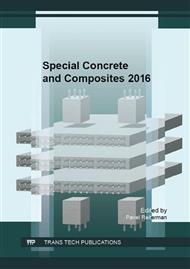[1]
V.M. Malhotra, P.K. Mehta, High-performance, high-volume fly ash concrete: materials, mixture proportioning, properties, construction practice, and case histories. Ottawa, Canada, (2002).
Google Scholar
[2]
D.N. Huntzinger, T.D. Eatmon. A life-cycle assessment of Portland cement manufacturing: comparing the traditional process with alternative technologies, J. of Cleaner Production 17 (2009) 668-675.
DOI: 10.1016/j.jclepro.2008.04.007
Google Scholar
[3]
P.K. Mehta, High-performance, high-volume fly ash concrete for sustainable development, International workshop on sustainable development and concrete technology, 2004 3-14.
Google Scholar
[4]
D.P. Bentz, C.F. Ferraris, I. de la Varga, M.A. Peltz, J.A. Winpigler. Mixture proportioning options for improving high volume fly ash concretes, International Journal of Pavement Research and Technology, 3 (2010) 234-240.
Google Scholar
[5]
R. Hela, J. Marsalova, L. Bodnarova, Fly Ashes Thermal Modification and their Utilization in Concrete, System-based Vision for Strategic and Creative Design, 1-3 (2003), 1649-1653.
Google Scholar
[6]
R. Hela, D. Orsakova, The Mechanical Activation of Fly Ash, concrete and concrete structures 2013, Procedia Engineering, 65 (2013), 87-93.
DOI: 10.1016/j.proeng.2013.09.016
Google Scholar
[7]
E.H. Kadri, S. Aggoun, G. de Schutter, K. Ezziane, Combined effect of chemical nature and fineness of mineral powders on Portland cement hydration, Materials and Structures, 43 (2010) 665-673.
DOI: 10.1617/s11527-009-9519-6
Google Scholar
[8]
P.K. Mehta, O.E. Gjørv, Properties of portland cement concrete containing fly ash and condensed silica-fume, Cement and Concrete Research, 12 (1982) 587-595.
DOI: 10.1016/0008-8846(82)90019-9
Google Scholar
[9]
G. Carette, V.M. Malhotra, Early age strength development of concrete incorporating fly ash and condensed silica fume. ACI SP79-41, 79 (1983) 765–784.
Google Scholar
[10]
A. Hubacek, M. Labaj, M. Tazky, Optimization of Concrete with High Volume of Fly Ash, Materials Science Forum, 865 (2016), 249-254.
DOI: 10.4028/www.scientific.net/msf.865.249
Google Scholar
[11]
S.A. Barbhuiya, J.K. Gbagbo, M.I. Russell, P.A.M. Basheer, Properties of fly ash concrete modified with hydrated lime and silica fume, Construction and Building Materials, 23 (2009) 3233-3239.
DOI: 10.1016/j.conbuildmat.2009.06.001
Google Scholar
[12]
T. Nochaiya, W. Wongkeo, A. Chaipanich, Utilization of fly ash with silica fume and properties of Portland cement–fly ash–silica fume concrete, Fuel, 89 (2010) 768-774.
DOI: 10.1016/j.fuel.2009.10.003
Google Scholar
[13]
A.M. Rashad, H.E.D.H. Seleem, A.F. Shaheen, Effect of Silica Fume and Slag on Compressive Strength and Abrasion Resistance of HVFA Concrete, International Journal of Concrete Structures and Materials, 8 (2014) 69-81.
DOI: 10.1007/s40069-013-0051-2
Google Scholar
[14]
F.U.A. Shaikh, S.W.M. Supit, P.K. Sarker, A study on the effect of nano silica on compressive strength of high volume fly ash mortars and concretes, Materials & Design, 60 (2014) 433-442.
DOI: 10.1016/j.matdes.2014.04.025
Google Scholar
[15]
R. Yu, P. Spiesz, H.J.H. Brouwers, Effect of nano-silica on the hydration and microstructure development of Ultra-High Performance Concrete (UHPC) with a low binder amount, Construction and Building Materials, 65 (2014) 140-150.
DOI: 10.1016/j.conbuildmat.2014.04.063
Google Scholar
[16]
M. Nili, A. Ehsani, K. Shabani, Influence of Nano-SiO2 and Microsilica on Concrete Performance, Second International Conference on Sustainable Construction Materials and Technologies, (2010) 1-5.
Google Scholar
[17]
G. Quercia, P. Spiesz, G. Hüsken, H.J.H. Brouwers, SCC modification by use of amorphous nano-silica, Cement and Concrete Composites, 45 (2014) 69-81.
DOI: 10.1016/j.cemconcomp.2013.09.001
Google Scholar


